Streets for People / Do Key West Commercial Areas Need Business Improvement Districts (BIDS)? – Part 2: What BIDS in Key West Might Look Like
Chris Hamilton. (Featured photo by Karrie Bond)
In Key West we’ve seen budding support for putting in parklets to widen the sidewalks, for restaurants and retailers to “take the streets” and even for some semblance of the return of Mall-on-Duval-like activities. Advocates have been calling for commercial streets that are more pedestrian oriented. The City’s COVID Recovery Plan recommends free transit, moving businesses outdoors and creating marketing and related support for local retailers. The City, in fits and starts, is trying to embark on a Duval Street Revitalization Study, envisioning a better looking and functioning N. Roosevelt business corridor, and conducting workshops aimed at projects to enhance the Mallory Sq./Sunset Celebration experience. And during the last year, the wonderful Mom&Pop Business Key West group was formed, to give local business operations a voice to improve things. It seems a missing element in all this is someone to organize and help businesses accomplish activities that will help them, and their immediate neighborhoods prosper. The businesses are too busy running their businesses and the City, well, they could probably use some help too. Might the answer be one or more Business Improvement Districts or BIDS in our commercial areas?
This is a big subject, so, we broke it into two stories. Last week, in Part 1 – What’s a BID? we tried to answer that question. This week in Part 2 – What BIDS in Key West Might Look Like, we’ll explore where BIDS might be able to help, how they might function and what they may be able to accomplish that isn’t happening now.
Part 1 – What’s a BID? Summary Recap
The International Downtown Association (IDA) says: “A Business Improvement District (BID) is a public/private partnership in which property and business owners elect to make a collective contribution to the maintenance, development and promotion of a commercial district.” Since the 1970’s nearly 1,000 BIDS in big cities (New York City has 76) and small towns across North America have popped up. As a Department of Transportation employee of Arlington County, Virginia government, I worked closely with six Arlington, Virginia business improvement districts over the years – each one being indispensable to helping its neighborhood thrive.
I witnessed local BIDS do small things like provide ambassadors on the street to welcome people and provide them with directions. They helped small shops with permits and applications. The local BIDS did extra sweepings of the streets and emptying of the trash cans. They sponsored branded benches, bus stops and recycle bins. They provided maps and wayfinding signage. ALL of the BIDS I worked with promoted walking, biking and transit and they directed workers and visitors to long-term parking and shoppers to short-term parking. They fostered farmer’s markets, block parties, movie nights, lectures, gallery walks, first Friday events to promote businesses and full blown one and two-day festivals of all sorts. And when it was a holiday or special occasion, they made sure the street light poles were festooned with flags sharing the moment as a neighborhood. They helped foster a stronger sense of place and belonging.
BIDs are financed primarily through a dedicated, add-on BID tax, assessed over and above normal real estate taxes. BIDS begin when a group of local businesspeople petitions a City to legally create one. In Florida a locality must authorize the creation of these districts. We found 16 BIDS in nine cities throughout Florida.
Part 2 – What BIDS in Key West Might Look Like
We intend this article to hopefully be the beginning of a discussion. I don’t pretend to know all the answers. I’m not a BID consultant. But as a local DOT employee up north, I worked closely with BIDS for a couple decades and my observation here in Key West is that our commercial areas could use some similar help. So…
The Key West Historic Seaport Acts Like a BID
Key West already has one BID-like organization. The Key West Historic Seaport. Back in the day, City Commissioner Jimmy Weekley and some other thoughtful folks, saved the Bight from certain overdevelopment into big hotels and timeshares, by using a similar State authority to BIDS, and created an entity to buy the property. While they are a city-agency, the Historic Seaport have their own income and budget, overseen by their own Key West Bight Management District Board of Directors. The Port and Marina Services Director and his team are City employees reporting to both their Board and the City Manager.
As they have their own budget, they have their own staff and contractors. The Bight Board and its staff:
- invest in infrastructure improvements to the site,
- operate the site, meaning they clean the area, trim the trees and landscaping, provide routine maintenance for all the common areas,
- assist the businesses with liaising, lobbying and troubleshooting with City and County agencies as individual businesses and as a powerful and unified group, AND
- they promote the businesses on the site and program the Key West Historic Seaport with unified, branding, marketing and events with the help of a marketing contractor that has over $344,000 annually to work with.
As we discussed in the first article, most BIDS across the country do for themselves numbers two, three and four and then they work with their locality to do number one.
Check out the Seaport’s web site. So, while their marketing firm is asking people to shop, dine and play at the Seaport, who’s doing that for businesses on our Main Street and other commercial areas?

Who’s Doing for Our Commercial Districts, What the Bight Board Does for the Historic Seaport
The short answer is that the City is responsible for 1. infrastructure and 2. operations, and no one is doing the 3. assistance/liaising with the government or 4. marketing. For example, the City’s Community Services Department is responsible for street cleaning every morning on Duval. It is also responsible for putting up barricades for events and for installing the Christmas wreathes on the street poles at the Holidays. The Bight Board does this for themselves. They also put in and maintain their own bike racks and more.
The City is stretched pretty thin as it is. With N. Roosevelt Boulevard and Mallory Sq. studies underway, what if those commercial neighborhoods wanted some of the extra services Duval Street receives? What if White Street asked for help installing holiday lights and wreathes? What if Duval Street wanted more? Certainly, the City has the resources and scale to do a lot of things, but what happens if we want to do more? Wouldn’t it be helpful to have BIDS or Historic Seaport-like operations in other parts of the City?
We should note that based upon community input, as part of the City’s COVID Recovery Plan, the City did recognize the need for numbers three and four and hired the wonderful Nadene Grossman Orr’s Team at Key West Events – We’ve Got the Keys to assist businesses with permits and compliance and to do some marketing. But the contract was only for three months and has already ended. If the City recognized this kind of help was needed for 3 months, why not longer?
What about the Chamber and Other Organizations?
We have a lot of organizations in Key West that may seem kind of related. The Key West Chamber of Commerce, the Key West Business Guild, the Lodging Association of the Florida Keys and Key West, the Key West Attractions Association, and just this year Shop Mom & Pop Key West was established. There’s also the Monroe County Tourist Development Council or TDC. They all do a fantastic job at what they do. I attend many of their functions. There’s indeed a little overlap, but do any of them specifically look out for and provide the kind of typical BID services at a neighborhood level like we’ve discussed here? The answer is no.
Key West Historic Seaport businesses belong to all these organizations and yet they also get the added help of their BID-like organization. That’s not to say one of these organizations couldn’t, if tasked with running a BID, do it. But none of them are providing those typical services to Duval Street or White Street or N. Roosevelt Boulevard at the moment. The creation of any BIDS would need to cede to these other organizations what they do best and concentrate on filling in the gaps, not duplicate services. Same goes with what the City does.
Could We Use One or More BIDS in Key West?
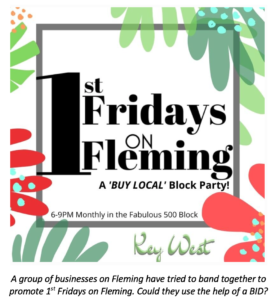 In our humble opinion, yes. Especially since the City sort of runs one already at the Historic Seaport. There isn’t a downtown commercial district in the North America worth its salt that doesn’t have one. Every BID I had the pleasure to work with made its neighborhood a better place and the businesses appreciated that.
In our humble opinion, yes. Especially since the City sort of runs one already at the Historic Seaport. There isn’t a downtown commercial district in the North America worth its salt that doesn’t have one. Every BID I had the pleasure to work with made its neighborhood a better place and the businesses appreciated that.
We’ve noticed many local business owners say they have problems getting permits for sidewalk seating and others don’t know where they’d even begin at the City if they wanted to put in a parklet in front of their business. Others have shared stories of receiving little support when they tried to participate in Mall on Duval. That and there seems to be a different City department for everything. Wouldn’t it be easier to have an advocate for neighborhood businesses? Someone who could help organize things. Our business districts are our city’s life blood. If we’re going to invest in infrastructure, shouldn’t we likewise invest in its smooth operations? Shouldn’t we likewise invest in helping those businesses be all they can be? Shouldn’t we also invest in marketing and creating a sense of place around these businesses that attract residents and visitors to use them, especially downtown? Yes.
Where Could We Use BIDS?
Duval Street. When I first started thinking about this subject, I was primarily thinking about Duval and adjacent 400 and 500 blocks on Front, Greene, Caroline, Eaton, Fleming, Southard, Angela, and Petronia because it is our Main Street corridor, and is also a focus of our Facebook page – Friends of Car-Free Key West & Duval Street/Historic Downtown. Following up on the demise of the Mall on Duval, the City has embarked on a path to do a “Duval Street Revitalization Study” that will enlist an engineering and planning consultant to help plan the revitalization of the infrastructure or streetscape of Duval. The Mayor said she envisions improvements including widening sidewalks and adding planters, benches and water fountains.
But once we renovate Duval Street, is that enough? Or do we need someone to help the businesses and community take advantage of and operate this improved asset? Yes, yes, we do.
The businesses themselves are too busy just trying to run their own operations. These days that’s harder than ever to do. Mom and Pop shops shouldn’t also be expected to figure out how to make all this happen, coordinate with each other and actually do it. While the City should certainly set the table and provide services and capital improvements for one of its most important assets, Duval Street, and they do, should they be expected to do all the work or even more work, especially the activities part? Or should there be some sort of empowered third-party organization that can take responsibility for helping small businesses thrive while liaising with and enhancing what the local government does do?
I talked to Paul J. Menta, the founder of Shop Mom & Pop Key West, and he enthusiastically liked the idea of a downtown BID, saying “Can I tell you; I love this! I want a downtown business district that connects all the areas and side streets.” He suggested perhaps a district with a historic theme shaped like the Duval Loop route that encourages visitors to hop on the Loop or other provided transit and try out each of the different areas. He went on to further advocate for better Loop-like (think frequent) service from Sugar Loaf to enable workers to get downtown.
While we prefer Paul’s idea of one downtown BID, focused mainly along Duval, it may make sense to break it up into multiple BIDS (yet still be connected up by frequent, free transit). In Arlington, Virginia the 2.3-mile-long R-B or Rosslyn-Ballston Corridor had 3 different BIDS covering it. Duval certainly has Lower, Middle and Upper sections, each with their own distinctive vibe. Or maybe each section is just marketed differently by one BID? Just food for thought.
Where Else Could We Use BIDS?
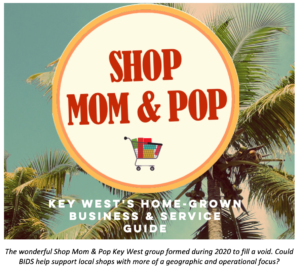 White Street. What about White Street from Petronia to United? This, sometimes called White Street Gallery District, has its own small-town flair and needs that may be worthy of some help.
White Street. What about White Street from Petronia to United? This, sometimes called White Street Gallery District, has its own small-town flair and needs that may be worthy of some help.
Petronia Street. The Bahama Village portion of Petronia Street is its own little paradise and has a rich history. Imagine if these businesses acted with one focus. And if this section was car-free.
Truman Avenue. Truman Avenue between White Street and Duval Street is a nice mixture of shops, hotels and a few restaurants and bars. Are they their own district or could they be folded into something nearby?
Roosevelt Boulevard. Perhaps our largest commercial district hugs N. Roosevelt Boulevard from the Triangle down to Truman Avenue. This diverse, car-centric area has needs that are very different than the places downtown. What are the possibilities of more unified planning, operations and marketing of this stretch of U.S. Route 1? Especially since the City is doing a survey of needs at the moment.
“Downtown” Stock Island. The I Love Stock Island Group already has a marketing presence, some great events and touts the local businesses. What if this was more formalized with a staff and budget to do more?
Funding
As we discussed last week, most BIDS are financed via an added tax on properties within the district. Section 511 of Florida Statues pertains to Special Neighborhood Improvements Districts, like BIDS. It authorizes these districts the ability, through the local government, to levy an ad valorem tax on real and personal property of up to 2 mills annually or up to $2 for every $1,000 of property value, which at max translates to $2,000 annually for every $1 million dollars in property value. Would Key West commercial property owners, like their counterparts in places across the country be willing to pay a little extra for these additional services? That’s a crucial question.
Perhaps in Key West there are opportunities for some innovative funding to keep any additional tax on commercial property owners even lower. The County’s Tourist Development Council (TDC) takes in an awful lot of money annually. Perhaps some of that money could be put to use enhancing our commercial districts’ operations rather than some of the money it spends on advertising Key West in general. Making the product they are advertising a stronger place might be a better way of attracting tourists, rather than clever marketing slogans. Just a thought. Other ideas?
Imagine What a Key West BIDS Might Accomplish
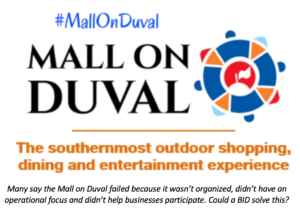 The easiest way to imagine what BIDS in Key West might accomplish, is to simply go back to the Key West Historic Seaport example and imagine having the cash and staff to do similar infrastructure, operations, business development and marketing in other areas.
The easiest way to imagine what BIDS in Key West might accomplish, is to simply go back to the Key West Historic Seaport example and imagine having the cash and staff to do similar infrastructure, operations, business development and marketing in other areas.
I’d imagine, for example on Duval Street, where there’s seemingly a festival every weekend, it would be easier for event organizers to work with a BID and the City rather than dozens of individual businesses and the City. We heard the Mall on Duval failed because it was badly organized and didn’t help the businesses participate. Failure would be less likely if there was a BID organizing the activities. Likewise, it is time-consuming and difficult to get dozens of businesses owners together for meetings. However, if BID staff can represent their neighborhood, operations and events, whether run by the City or private entities, can be made to run smoother.
Imagine a unified website for the district with information for residents and visitors and property owners. Instead of just Christmas wreathes during December, banners and flags could be programmed throughout the year, providing a unified look.
Imagine that wayfinding signage was installed directing people to each of the micro-neighborhoods in and around Duval. Imagine that visitors were further provided information on where to rent bikes and to catch transit. Even better that there is unified promotion of long-term parking lots so that short-term metered parking can be used for shopping and dining.
While the City does a nice job cleaning the streets each morning on Duval, imagine if there was a little team that could trouble-shoot and supplement this service throughout the day and evening. The same people could act as easily identifiable ambassadors to answer questions and they could also act as the eyes and ears on the ground and alert the police or public works when something goes awry like a broken streetlight, abandoned bikes, malfunctioning traffic signal or illegal trash dumping.
Further imagine that the BID could raise money and plan for small improvements such as street furniture, bike racks, benches, parklets, water fountains and additional trees and landscaping. Perhaps they could even help Key West Transit install map and signage information at every bus stop in their district.
Imagine a new business needs assistance with getting an outdoor seating permit or permission to set up a parklet or needs help navigating other City, County and State rules. The BID could step in and help. They could even work with the Chamber and other organizations to foster lectures and seminars to help the businesses.
What’s Next?
Typically, BIDS begin when a group of local businesspeople or a local business organization petitions a City to legally create one. Often BIDS are fostered by local governments that realize they can’t do everything themselves and could use some help. But the City won’t act unless there’s a groundswell from the businesspeople in these places to rally for something like this. A BID is a mechanism to provide help to businesses and their neighborhood. But they need to ask the City for help to make it so.
Could the Duval Street Revitalization Study Look into Creating a BID?
Perhaps the best avenue to approach this subject, at least for Duval Street, is via the Duval Street Revitalization Study process. The City still hasn’t contracted with a firm to do the work. While the Study is focusing on infrastructure, it seems appropriate that the selected consultant, in consultation with the business community and public, could come up with recommendations and action items relating to a Duval Street or Downtown BID overseeing this enhanced asset too.
Likewise, perhaps the N. Roosevelt study could look into the same. Potential districts on White Street and Stock Island may need to grab the bull by the horn themselves.
Final Takeaway – A Rising Tide Lifts All Ships
Instead of dozens or hundreds of businesses in a local neighborhood competing with each other to be seen and heard, with unified neighborhood operations under a BID umbrella, a rising tide lifts each individual business. Now’s the time to learn more, think it through and hopefully have a good discussion about creating BIDS during these upcoming planning processes. Our commercial districts are too important to just leave their success to chance. Let’s help make that discussion happen.
# # #
You can find all the KONK Life Streets for People column articles here and recent stories below:
- Do Key West Commercial Areas Need Business Improvement Districts (BIDS)? – Part 1: What’s a BID?; April 16, 2021
- The Good, the Bad and the Ugly – A Dozen Marketing Things KW Transit Can Do to Increase Ridership; April 9, 2021
- The Sorry State of Key West Bus Stops – We Just Don’t Care; April 2, 2021
- It’s Time to Reconsider a Road Diet on S. Roosevelt and Make the Promenade and Road Safer; March 26, 2021
- Getting the Parking Right Leads to Streets for People – Part 2: Battling Our Inner George Costanza – Ten Things We Can Do in Downtown Key West to Get the Parking Right; March 19, 2021
- Getting the Parking Right Leads to Streets for People – Part 1: Nobody Goes there Anymore. It’s Too Crowded – Six Reasons for Right Pricing Parking; March 12, 2021
- Eight Things We Can Do to Pedestrianize Duval and Still Allow Cars, March 5, 2021
- How We Get Wider Sidewalks Downtown Without Ripping Up the Streets – Parklets; February 26, 2021
- The Wee Donkey, Whataboutism, Bathwater and Duval Street’s Future; February 19, 2021
- Averting E-Bike Mayhem and Making Key West Sidewalks Safer; February 12, 2021
- Sustainability Board Wants to Make Free, Frequent and Simple Key West Transit a Reality, February 5, 2021
- Volunteers and a Little Green Paint Show How We Can Make it Safer to Bike; January 29, 2021
Chris Hamilton is founder of the local advocacy group Friends of Car-Free Key West & Duval Street/Historic Downtown. He’s a native of the District of Columbia, where for a couple decades+ he led nationally renowned efforts promoting transit, bike, walk and smart growth for Arlington County, VA’s DOT. Chris has lived in Key West since 2015. He lives downtown and works and volunteers for a couple non-profits.
[livemarket market_name="KONK Life LiveMarket" limit=3 category=“” show_signup=0 show_more=0]




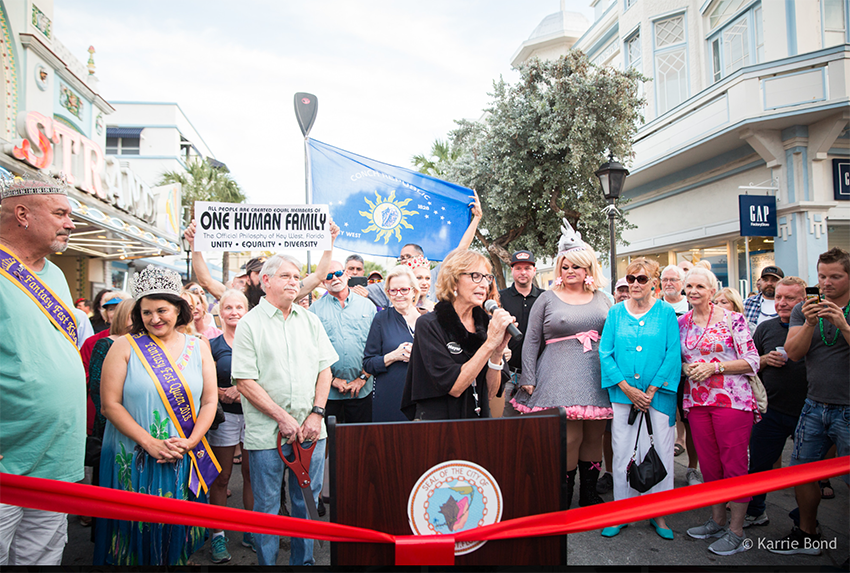


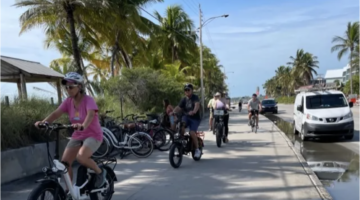
No Comment